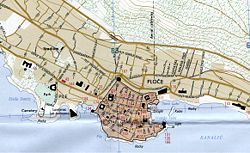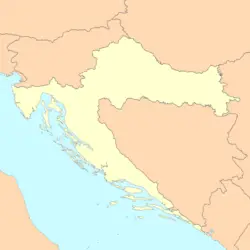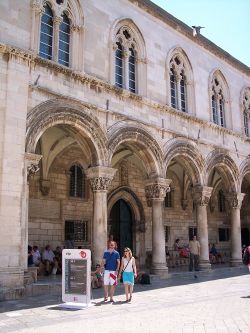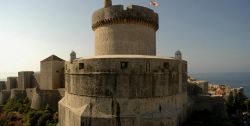Dubrovnik
| ||||||||||||||||||||||||||||||||||||||||||||
File:Old City, Dubrovnik.jpg Rooftops in Dubrovnik's Old City, a UNESCO World Heritage Site. | ||||||||||||||||||||||||||||||||||||||||||||
 Dubrovnik bridge of Franjo Tuđman and the Port of Gruž | ||||||||||||||||||||||||||||||||||||||||||||
- For the Yugoslav destroyer, see Dubrovnik (ship).
Dubrovnik (IPA: [ˈdǔ.bro̞ːʋ.niːk]; Dalmatian: Ragusa; Latin: Ragusium, also Rhausium, Rhaugia; Italian: Ragusa) is a city on the Adriatic Sea coast in the extreme south of Croatia. Regarded as the most picturesque city on the Dalmatian coast, it is one of the most prominent tourist destinations on the Adriatic, a seaport and the centre of Dubrovnik-Neretva county.
In 1979, the city of Dubrovnik joined the UNESCO list of World Heritage Sites.
The prosperity of the city of Dubrovnik has always been based on maritime trade. In the Middle Ages, as the Republic of Ragusa, it became the only eastern Adriatic city-state to rival Venice. Supported by its wealth and skilled diplomacy, the city achieved a remarkable level of development, particularly during the 15th and 16th centuries. Ragusa was one of the centres of the development of primarily the Croatian language and literature, home to many notable poets, playwrights, painters, mathematicians, physicists and other scholars.
Geography
The Slavic toponym Dubrovnik originates from the Proto-Slavic term for an oak forest *dǫbrava or *dǫbrova (dubrava in archaic and literary Croatian), which was abundantly present in the hills north of the walled city of Dubrovnik by the end of the 11th century. The current name was officially adopted in 1909, when the city was under Austro-Hungarian rule.
Positioned at the terminal end of the Isthmus of Dubrovnik, the city is located on a promontory jutting into the sea under the bare limestone Mount Srdj.
Elevation Climate (not required unless it makes the city a resort) The city (Johannesburg) enjoys a dry, sunny climate, with the exception of occasional late afternoon downpours in the summer months of October to April. Temperatures are usually fairly mild due to the city's high altitude, with the average maximum daytime temperature in January of 79°F (26°C), dropping to an average maximum of around 61°F (16°C) in June. Winter is the sunniest time of the year, with cool days and cold nights. The temperature occasionally drops to below freezing at night, causing frost. Snow is rare. Mean annual precipitation is 28 inches (716mm). Rivers and canals Size – land area, size comparison Environmental issues Districts
History
From the foundation to the end of the Republic
Ragusa (Raugia) was founded in the 7th century on a rocky island named Laus, which provided shelter for Latin refugees from the nearby city of Epidaurus, today's Cavtat also Ragusavecchia. Some time later a settlement of Slavic people grew at the foot of the forested Srđ hill. This settlement gives to the city its Slavic name "Dubrovnik".
The strip of wetland between Ragusa and Dubrava was reclaimed in the 12th century, unifying the city around the newly-made plaza (today Placa or Stradun). The plaza was paved in 1468 and reconstructed after the earthquake of 1667. The city was fortified and two harbours were built on each side of the isthmus.
From its establishment in the 7th century, the town was under the protection of the Byzantine Empire. After the Crusades, Ragusa/Dubrovnik came under the sovereignty of Venice (1205–1358), and by the Peace Treaty of Zadar in 1358, it became part of the Hungaro-Croatian reign.
Between the 14th century and 1808 Ragusa ruled itself as a free state. The Republic had its peak in the 15th and 16th centuries, when its thalassocracy rivaled that of the Republic of Venice and other Italian maritime republics.
The Republic of Ragusa received its own Statutes as early as 1272, statutes which, among other things, codified Roman practice and local customs. The Statutes included prescriptions for town planning and the regulation of quarantine (for hygienic reasons). The Republic was very inventive regarding laws and institutions that were developed very early:
- Medical service was introduced in 1301
- The first pharmacy (still working) was opened in 1317
- A refuge for old people was opened in 1347
- The first quarantine hospital (Lazarete) was opened in 1377
- Slave trading was abolished in 1418
- The orphanage was opened in 1432
- The water supply system (20 kilometers) was constructed in 1436
The city was ruled by aristocracy that formed two city councils. As usual for the time, they maintained a strict system of social classes. The republic abolished the slave trade early in the 15th century and valued liberty highly. The city successfully balanced its sovereignty between the interests of Venice and the Ottoman Empire for centuries.
The economic wealth of the Republic was partially the result of the land it developed, but especially of the seafaring trade it did. With the help of skilled diplomacy, Ragusa's merchants traveled lands freely, and on the sea the city had a huge fleet of merchant ships (argosy) that traveled all over the world. From these travels they founded some settlements, from India to America, and brought parts of their culture and vegetation home with them. One of the keys to success was not conquering, but trading and sailing under a white flag with the word freedom (Latin: Libertas) prominently featured on it. That flag was adopted when slave trading was abolished in 1418.
Many Conversos (Marranos) — Jews from Spain and Portugal — were attracted to the city. In May, 1544, a ship landed there filled exclusively with Portuguese refugees, as Balthasar de Faria reported to King John. During this time there worked in the city one of the most famous cannon and bell founders of his time: Ivan Rabljanin (Magister Johannes Baptista Arbensis de la Tolle).
The Republic gradually declined after a crisis of Mediterranean shipping — and especially a catastrophic earthquake in 1667 that killed over 5000 citizens, including the Rector, leveling most of the public buildings — ruined the well-being of the Republic. In 1699 the Republic sold two patches of its territory to the Ottomans in order to avoid terrestrial borderline, with advancing Venetian forces. Today this strip of land belongs to Bosnia and Herzegovina and is its only direct access to the Adriatic.
In 1806 the city surrendered to French forces, as that was the only way to cut a month's long siege by the Russian-Montenegrin fleets (during which 3000 cannonballs fell on the city). At first Napoleon demanded only free passage for his troops, promising not to occupy the territory and stressing that the French were friends of the Ragusans. Later, however, French forces blockaded the harbours, forcing the government to give in and let French troops enter the city. On this day, all flags and coats of arms above the city walls were painted black as a sign of grief. In 1808, Marshal Marmont abolished the republic and integrated its territory into the Illyrian provinces.
Austrian rule
When the Habsburg Empire gained these provinces after the 1815 Congress of Vienna, the new imperial authorities installed a bureaucratic administration, which retained the essential framework of the Italian-speaking system. It introduced a series of modifications intended to centralize, albeit slowly, the bureaucratic, tax, religious, educational, and trade structures. Unfortunately for the local residents, these centralization strategies, which were intended to stimulate the economy, largely failed. And once the personal, political and economic trauma of the Napoleonic Wars had been overcome, new movements began to form in the region, calling for a political reorganization of the Adriatic along national lines.
The combination of these two forces—a flawed Habsburg administrative system and new national movements claiming ethnicity as the founding block towards a community—created a particularly perplexing problem; for Dalmatia was a province ruled by the German-speaking, centralizing Habsburg monarchy, with Italian-speaking elites that dominated a general population consisting of a Croatian, Catholic Slav majority and strong Serb Orthodox minority. Though always an unreliable estimate[citation needed], census takers in 1846 counted 16,000 Italians, 320,000 Croatians and 80,000 Serbs.
In 1815 the former Ragusan Government, i.e. its noble assembly, met for the last time in the ljetnikovac in Mokošica. Once again heavy efforts were undertaken to reestablish the Republic however this time it was all in vain. After fall of the Republic most of the aristocracy died out or emigrated overseas. Others were recognized by Austrian Empire.
In 1832 Baron Sigismondo Ghetaldi-Gondola (*1795 +1860) was elected podestá of Ragusa, he served for 13 years, the Austrian government granted with the title of "Baron".
Count Raphael Pozza (Rafo Pucic) (*1828 +1890), Dr. Jur., was elected for first time Podestà of Ragusa in the year 1869 after this was reelected in 1872, 1875, 1882, 1884) and elected two times into the Dalmatian Council, 1870, 1876.
In 1848, Croatian Assembly (Sabor) published People's Requests in which they requested among other things abolition of serfdom and the unification of Dalmatia with rest of Croatian lands (primarily with Austro-Hungarian Kingdom of Croatia). Dubrovnik municipality was the most outspoken of all Dalmatian communes in its support for unification with Croatia. A letter was sent to Zagreb with pledges to work on this idea. In 1849, Dubrovnik continued to lead Dalmatian cities in the struggle for unification. A large-scale campaign was launched in the local paper L'Avvenire (The Future) based on a clearly formulated programme: the federal system for Habsburg territories, inclusion of Dalmatia into united Croatia and Slavic brotherhood.
In the same year, first issue of the Dubrovnik almanac appeared, Flower of the National Literature (Dubrovnik, cvijet narodnog knjizevstva), in which Petar Preradović published his noted poem "To Dubrovnik". This and other literary and journalistic texts, which continued to be published, contributed to awakening of national consciousness reflected in efforts to introduce Croatian language into schools and offices, and to promote Croatian books. The Emperor Franz Joseph brought the so-called Imposed Constitution which prohibited unification of Dalmatia and Croatia and also any further political activity with this end in view. The political struggle of Dubrovnik to be united with Croatia, which was intense throughout 1848 and 1849, did not succeed at that time.
In 1861 the Dalmatian Assembly met for the first time, with representatives from Ragusa. Representatives of Cattaro (now Kotor) came to join the struggle for unification with Croatia. The citizens of Ragusa gave them a festive welcome, flying Croatian flags from ramparts, and exhibiting slogan: Ragusa with Cattaro. The people of Cattaro elected a delegation to go to Vienna; Ragusa nominated Niko Pucić (National Party). Niko Pucić went to Vienna to demand not only the unification of Dalmatia with Croatia, but also the unification of all Croatian territories under one common Assembly.
Austrian rule and Austro-Hungarian rule which followed lasted for more than a century and were typified by the motto of the world powers of that time: Divide et impera (Divide and rule). Austrian policy of denationalizing the Dalmatian coasts and favoring the immigrant Italian minority left its mark in the political division of the population as best expressed in the political parties: the Croatian People's Party and the Autonomous Party (Conte Francesco Borelli (*1810 +1884) said: we are slavs for nationality but Italian for culture (the dalmatian were born to the sea (adriatic sea).... the autonomist want a multicultural region, with respect for the ancient Italian roots and the slavs tradition, about the Dalmatia destiny, they deny the unification with Croatia, because Dalmatia had different roots and multicultural traditions: croatian catholics, serbian orthodox, Serbian-Croat muslims, italian dalmatian, the people were bilingual, spoken slavonian (dialect modern serbo-Croat) and Italian (istrian, dalmatian-veneto dialect), etc.).
This political division also had its roots in class, as the greater part of the autonomous party, which wanted Dalmatian autonomy withinin frame of Austria and was against joining the other parts of Croatia, as wanted by Croatian People's Party, belonged to the richer strata of officials and administrators.
In 1889, Serbian political circle in Dubrovnik supported Baron Francesco Ghetaldi-Gondola, candidate of Autonomous Party, vs the candidate of Popular Party Vlaho de Giulli, in 1890 election to Dalmatian Diet.[1] Following year during the local government election, Autonomous Party with Serbian Party obtain the municipal reelection with Frano Gondola, who died in charge 1899, the aliance won again the election 27 May 1894. Francesco Ghetaldi-Gondola was founded the Societa Philately in 4 December 1890.
In 1893, the minister of the city, Baron Francesco Ghetaldi-Gondola, opened the monument for Ivan Gundulić in Piazza Gundulić (Gondola).
1921–1991
With fall of Austria-Hungary in 1918, the city was incorporated into the new Kingdom of Serbs, Croats, and Slovenes (later the Kingdom of Yugoslavia). The name of the city was officially changed from Ragusa to Dubrovnik.
In 1921 Pero Cingrija died (born 1837), politician and one of the leaders of the People's Party in Dalmatia. It was thanks to his efforts that the People's Party and the Party of Right were fused into one Croatian Party in 1905
In World War II, Dubrovnik became part of the Nazi puppet Independent State of Croatia, occupied by an Italian army first, and by a German army after September 1943. In October 1944 Tito's partisans entered Dubrovnik, that became consequently part of Communist Yugoslavia. Soon after their arrival into the city, Partisans sentenced approximately 78 citizens to death without trial, including a Catholic priest.[2]
Breakdown of Yugoslavia
In 1991 Croatia and Slovenia, which at that time were republics within Socialist Federal Republic of Yugoslavia, declared their independence. At that event, Socialist Republic of Croatia was renamed Republic of Croatia.
Despite demilitarization of the old town in early 1970s in an attempt to prevent it from ever becoming a casualty of war, following Croatia's independence in 1991, Serbian-Montenegrin remains of Yugoslav People's Army (JNA) attacked the city. The regime in Montenegro led by Momir Bulatovic which was installed and loyal to the Serbian government led by Slobodan Milosevic declared that Dubrovnik would not be permitted to remain in Croatia because they claimed that it was historically part of Montenegro.[1] This was in spite of the large Croat majority in the city and that very few Montenegrins resided there, though Serbs accounted for six percent of the population.[2] Many consider the claims by the Bulatovic government, as being part of Serbian President Milosevic's plan to deliver his nationalist supporters the Greater Serbia they desired as Yugoslavia collapsed.[3]
On October 1, 1991 Dubrovnik was attacked by JNA with a siege of Dubrovnik that lasted for seven months. Heaviest artillery attack happened on December 6 with 19 people killed and 60 wounded. Total casualties in the conflict according to Croatian Red Cross were 114 killed civilians, among them celebrated poet Milan Milisić. In May 1992 the Croatian Army liberated Dubrovnik and its surroundings, but the danger of sudden attacks by the JNA lasted for another three years.
Following the end of the war, damage caused by the shelling of the Old Town was repaired. Adhering to UNESCO guidelines, repairs were performed in the original style. As of 2005, most damage had been repaired. The inflicted damage can be seen on a chart near the city gate, showing all artillery hits during the siege. ICTY indictments were issued for JNA generals and officers involved in the bombing.
The final report of the United Nations Commission of Experts says:
Due to the ideal observation capacity that the JNA enjoyed through its command of the high ground, the air, and the sea, it seems clear that (at best) the JNA was indifferent to the civilian casualties it caused or (at worst) it deliberately and systematically targeted civilians and civilian objects throughout this period.
General Pavle Strugar, who was coordinating the attack on the city, was sentenced to an eight year prison term by the International Criminal Tribunal for the former Yugoslavia for his role in the attack of the city.
The 1996 Croatia USAF CT-43 crash killed everyone on a United States Air Force jet with VIP passengers.
Video of the attack on Dubrovnik
Government
Economy
Overview – Any specialization: For instance, is a manufactured product is associated with particular cities a. Milwaukee—cheese and beer b. Los Angeles—entertainment industry c. Sheffield—coal d. top 20 cities in the U.S. are highly specialized
Per capita GDP, rank Financial and business services sector Tourism Manufacturing Transport: Road, rail, air, sea
Demographics
Its population was 43,770 in 2001[3] down from 49,728 in 1991.[4]
In the 2001 census, 88.39% of its citizens declared themselves as Croats.
Language Religion Colleges and universities
Of interest
| Old City of Dubrovnik* | |
|---|---|
| UNESCO World Heritage Site | |
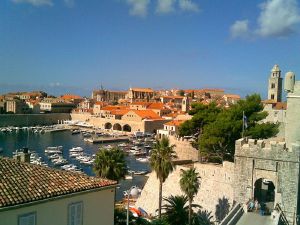
| |
| State Party | |
| Type | Cultural |
| Criteria | i, iii, iv |
| Reference | 95 |
| Region** | Europe and North America |
| Inscription history | |
| Inscription | 1979 (3rd Session) |
| Extensions | 1994 |
| Endangered | 1991-1998 |
| * Name as inscribed on World Heritage List. ** Region as classified by UNESCO. | |
The annual Dubrovnik Summer Festival is a cultural event when keys of the city are given to artists who entertain Dubrovnik's population and their guests for entire month with live plays, concerts, and games.
Ivan Gundulić, a 17th century Croatian writer, predicted the downfall of the great Turkish Empire in his great poem Osman. He wrote these immortal verses that are performed on every opening of the world famous Dubrovnik Summer Festival:
O, beautiful liberty, dear and sweet,
Thou heavenly gift where riches all meet,
Actual source of our glory of these hours,
The sole adornment of this grove of ours,
All silver, all gold, and our lives so dear,
Cannot recompense thy beauty so clear.
With these verses Dubrovnik major invites actors and poems to enter through main gates inside city stone walls. As a young actor Goran Višnjić played Hamlet at the Dubrovnik Summer Festival. He was noticed and approved by the public at the very start of his career. The Dubrovnik Summer Festival has been awarded its first Gold International Trophy for Quality (2007) by the Editorial Office in collaboration with the Trade Leaders Club.
February 3 is the feast of Sveti Vlaho (Saint Blaise), who is the city's patron saint. Every year the city of Dubrovnik celebrates the holiday with Mass, parades, and festivities that last for several days.[5]
Dubrovnik and its surroundings with numerous islands have a lot to offer in touristic activities for younger generations. Also popular are climbing on steep hills, hiking through the Mediterranean nature, and swimming in the clean, transparent sea.
New historical discoveries say that the usual misconception of Dubrovnik coming to be as joining of Laus island and Slav settlement of Dubrovnik is disputed by the fact that there was no island of Laus, only a peninsula, and it seems that there was a port on its location dating back to ancient history (thought to be the lost port of Heraclea).[citation needed]
The patron saint of the city is Sveti Vlaho (Saint Blaise), whose statues are seen around the city. He has an importance similar to that of St. Mark the Evangelist to Venice. The city's cathedral is named after Saint Blaise. The city boasts of many old buildings, such as the Arboretum Trsteno, the oldest arboretum in the world, dating back to before 1492. Also, the third oldest European pharmacy is located in the city, which dates back to 1317 (and is the only one still in operation today). It is located at Little Brothers church in Dubrovnik.[6]
In history, many Conversos (Marranos) were attracted to Dubrovnik, formerly a considerable seaport. In May, 1544, a ship landed there filled exclusively with Portuguese refugees, as Balthasar de Faria reported to King John. Another admirer of Dubrovnik, George Bernard Shaw, visited the city in 1929 and said: "If you want to see heaven on earth, come to Dubrovnik." This sentence is commonly used by tourist guides to describe the city.
In the bay of Dubrovnik is the 72-hectare wooded island of Lokrum, where according to legend, Richard the Lionheart was cast ashore after being shipwrecked in 1192. The island includes a fortress, botanical garden, monastery and naturist beach.
Dubrovnik has also been mentioned in popular film and theater. In the film 20,000 Leagues Under the Sea with Michael Caine, one of the characters said to have been dreaming of fairy from Dubrovnik (motive known from local legends and literature). In the film Rosemary's Baby, Roman Castevet, the leader of the witch coven, is falsely said to be in Dubrovnik, leading Rosemary to exclaim on his presence, "You're in Dubrovnik, I can't hear you." The 12th season of The Amazing Race, the remaining contestants went to the city of Dubrovnik.
Important monuments
Few of Dubrovnik's Renaissance buildings survived the earthquake of 1667 but fortunately enough remain to give an idea of the city's architectural heritage. [citation needed] The finest Renaissance highlight is the Sponza Palace which dates from the 16th century and is currently used to house the National Archives. The Rectors Palace is a Gothic-Renaissance structure that displays finely-carved capitals and an ornate staircase. It now houses a museum. The St Saviour Church is another fine remnant of the Renaissance period, next to the much-visited Franciscan Monastery. Over the entrance is a sculpture of the Pieta that dates from the late-Gothic period but the best part of the monastery is the Cloister with a colonnade of octagonal columns.
Dubrovnik's most beloved church is St Blaise's church, built in the 18th century in honor of Dubrovnik's patron saint. Dubrovnik's baroque Cathedral was built in the 18th century and houses an impressive Treasury with relics of Saint Blaise. The city's Dominican Monastery resembles a fortress on the outside but the interior contains an art museum and a Gothic-Romanesque church. [citation needed]
A striking feature of Dubrovnik is its walls that run 2km around the city. The walls run from four to six metres thick on the landward side but are much thinner on the seaward side. The system of turrets and towers were intended to protect the vulnerable city but now make one of the most picturesque sights in the Adriatic.[7]
Transport
Dubrovnik has an international airport of its own. The airport is located approximately 20 km (12 mi) from Dubrovnik city center, near Ćilipi. Buses connect the airport with the Dubrovnik bus station. In addition, a network of modern, local buses connects all Dubrovnik neighborhoods running frequently from dawn to midnight.
The A1 highway, in use between Zagreb and Šestanovac, is planned to be extended all the way to Dubrovnik. The highway will cross the, currently in construction, Pelješac Bridge. An alternative plan proposes the highway running from Neum through Bosnia and Herzegovina and an expressway continuing to Dubrovnik. This plan has fallen out of favor, though.
Education
Dubrovnik has a number of educational institutions. These include the University of Dubrovnik, a Nautical College, a Tourist College, a University Centre for Postgraduate Studies of the University of Zagreb, American College of Management and Technology, and an Institute of History of the Croatian Academy of Sciences and Arts.
Notable people from Dubrovnik
- Franco Sacchetti (1332-1400), Italian poet
- Marin Držić (1508-1567), Croatian playwright and prose writer
- Cvijeta Zuzorić (c. 1552 - c. 1600), Croatian poetess
- Dinko Zlatarić (1558-1613), Croatian poet and translator
- Marin Getaldić (1568–1626), Croatian scientist
- Ivan Gundulić (1589-1638) Croatian poet
- Ruđer Bošković (1711-1787), Croatian scientist, diplomat and poet
- Vlaho Getaldić (1788-1872), politician, noble, poet
- Niko Pucić (1820-1883) - Croatian politician and nobleman
- Medo Pucić (1821-1882) - Croatian writer, politician and nobleman
- Federico Seismit-Doda (1825-1893), Italian politician
- Frano Getaldić-Gundulić (1833-1899) - soldier, statesman, nobleman, Knight of Malta
- Pero Budmani (1835-1914), linguist
- Vlaho Bukovac (1855-1922),Croatian painter
- Ivo Vojnović (1857-1929), Croatian writer
- Antun Fabris (1864-1904), Croatian journalist and politician
- Frano Supilo (1870-1917), Croatian politician and journalist
- Blagoje Bersa (1873-1934),Croatian musician
- Eduard Miloslavić (1884-1952), scientist
- Branko Bauer (born 1921), Croatian film director
- Ottavio Missoni (born 1921), Italian fashion designer
- Marin Bunić (1924-1994), World War II survivor who led Croatian immigration wave to Lima, Peru
- Tereza Kesovija (born 1938), Croatian singer
- Božo Vuletić (born 1958), Croatian waterpolo player, Olympic gold medalist
- Goran Sukno (born 1959), Croatian waterpolo player, Olympic gold medalist
- Veselin Đuho (born 1960), Croatian waterpolo player and coach, double Olympic gold medalist
- Sanja Jovanović (born 1986), Olympic swimmer
Images
Panorama
Gallery
- Orlando, Dubrovnik, Croatia.JPG
The Orlando statue, symbol of a free city
- Dubrovnik walls.JPG
Dubrovnik as seen from its wall
See also
- Atlantska Plovidba d.d.
ReferencesISBN links support NWE through referral fees
- ↑ http://books.google.cl/books?lr=&id=GOVJAAAAMAAJ&dq=dubrovnik+gondola&q=gondola&pgis=1
- ↑ Nakon ulaska partizana u Dubrovnik u listopadu 1944.: Partizani pogubili hrvatske antifašiste | Izdvojeno | Glas Koncila
- ↑ City of Dubrovnik. Dubrovnik.hr. Accessed on July 2, 2007
- ↑ Dubrovnik. History.com Encyclopedia. Accessed on July 2, 2007
- ↑ Dubrovnik news
- ↑ Dubrovnik Online, monuments in Dubrovnik
- ↑ Croatia Traveller, Dubrovnik
Further reading
- Harris, Robin. Dubrovnik, A History. London: Saqi Books, 2003. ISBN 0-86356-332-5
- Kremenjas-Danicic, Adriana (Editor-in-Chief): Roland's European Paths. Dubrovnik: Europski dom Dubrovnik, 2006. ISBN 953-95338-0-5
External links
- Dubrovnik, Croatia BBC World Weather,Retrieved September 17, 2008.
- Old City of Dubrovnik - UNESCO World Heritage Centre
- Dubrovnik picture gallery
- Dubrovnik Map - A Free Satellite image of Dubrovnik with pins on all important tourist locations.
Credits
New World Encyclopedia writers and editors rewrote and completed the Wikipedia article in accordance with New World Encyclopedia standards. This article abides by terms of the Creative Commons CC-by-sa 3.0 License (CC-by-sa), which may be used and disseminated with proper attribution. Credit is due under the terms of this license that can reference both the New World Encyclopedia contributors and the selfless volunteer contributors of the Wikimedia Foundation. To cite this article click here for a list of acceptable citing formats.The history of earlier contributions by wikipedians is accessible to researchers here:
The history of this article since it was imported to New World Encyclopedia:
Note: Some restrictions may apply to use of individual images which are separately licensed.

